GitHub this week introduced NPM package provenance and deployment protection rules and announced general availability of private vulnerability reporting.
The post GitHub Announces New Security Improvements appeared first on SecurityWeek.
GitHub this week introduced NPM package provenance and deployment protection rules and announced general availability of private vulnerability reporting.
The post GitHub Announces New Security Improvements appeared first on SecurityWeek.
Mighty Morphin Power Rangers: Once & Always has flicked the nostalgia switch on Netflix and we explain why Amy Jo Johnson was not involved as Kimberly, the Pink Ranger, and discuss where the actor is now.
If you’re wondering why the reunion is titled “Once & Always,” we discussed the iconic Power Ranger quote that it’s based on.
Directed by Charlie Haskell and written by Becca Barnes and Alwyn Dale for Netflix, the reunion special follows the returning superheroes in a stand-alone web special to celebrate the 30th anniversary of the 90s show and the overall Power Rangers franchise.
After dedicating most of the 90s to Power Rangers, starring in the original Mighty Morphin Power Rangers television series, the 1995 movie, and the 1997 Turbo movie, Amy Jo Johnson also appeared in other 90s hits including Saved by the Bell: The New Class and the movie, Perfect Body.
Post-Power Rangers, Johnson appeared in TV shows ER, Flashpoint, and Covert Affairs, alongside a small cameo role in the Power Rangers reboot movie in 2017.
Recently, Johnson starred in the miniseries, The Has Been, and movies Between Waves and Space & Time, however, her time is currently spent behind the camera as a director.
After spending a few years directing shorts, Johnson recently helmed the movie Tammy’s Always Dying in 2019 and the miniseries, The Has Been, which she also starred in.
Additionally, Johnson directed season 2 episode 6 of the Superman and Lois series for The CW, titled Tired and True.
It was also recently reported by Variety that Johnson is writing her own Power Rangers comic book series with publisher Boom Studios. The professional raised $250,000 on Kickstarter in less than 24 hours for the comic titled: Power Rangers: A 30th Anniversary Comic Book Celebration.

After a number of Johnson’s co-stars returned for the Netflix anniversary special, the actor was targeted by fans who spread false claims about her absence from the special.
Entertainment Weekly reported Johnson’s response to fans who believed the actor decline the opportunity because she was not offered enough money:
“Please stop saying I didn’t do reunion because of money. Simply not true. Maybe I just didn’t want to wear spandex in my 50s. Or couldn’t go to NZ for a month. Or none of [your] beeswax.”
The first generation Pink Ranger, Kimberly, actually appeared in Power Rangers: Once & Always, alongside Tommy Oliver as the Green Ranger and Jason as the Red Ranger. However, their faces are never seen and they have no speaking lines.
Amy Jo Johnson as Kimberly Hart/Pink Ranger.???? pic.twitter.com/zYMlK7pLL3
— Beni (@SzollosyBenedek) April 19, 2023
Walter Jones and David Yost return to their first-generation mantles from the 90s television series, playing the Black Ranger, Zach, and the Blue Ranger, Billy, respectively.
Steve Cardenas returns as the second-generation Red Ranger, who took over from Austin St. John, and second-generation Pink Ranger, Catherine Sutherland, who took over the mantle from Amy Jo Johnson.
Below, we have listed the cast members of the special:
By Jo Craig – jo.craig@grv.media
Mighty Morphin Power Rangers: Once & Always is now streaming on Netflix.
The post Amy Jo Johnson debunks rumors of Power Rangers Once & Always pay dispute appeared first on ForeverGeek.
|
RAWINPUTDEVICE rid[3]={0}; rid[0].usUsagePage = 0x01; rid[0].usUsage = HID_USAGE_GENERIC_MOUSE; rid[0].dwFlags = RIDEV_REMOVE; rid[0].hwndTarget = hWnd; // keyboard rid[1].usUsagePage = 0x01; rid[1].usUsage = HID_USAGE_GENERIC_KEYBOARD; rid[1].dwFlags = RIDEV_REMOVE; rid[1].hwndTarget = hWnd; ::RegisterRawInputDevices(rid, 2, sizeof(RAWINPUTDEVICE)); |
| 757 //Save this structure to return with GetRegisteredRawInputDevices 758 b_registered_mouse = TRUE; 759 memcpy(&rid_mouse, &pRawInputDevices[i], sizeof(RAWINPUTDEVICE)); 760} else { 761 //Remove 762 TRACE("user32: Removing a RAWINPUT mouse\n"); + if (UseDirectInput && m_mouse == NULL) { + RegisterDirectInputMouse(&pRawInputDevices[i], hWnd); + } 764 if(pRawInputDevices[i].hwndTarget) { 765 //This actually is not allowed 766 RemoveNodeByVal(rawMouseInputWindowList, (DWORD)pRawInputDevices[i].hwndTarget); 767 } else { |
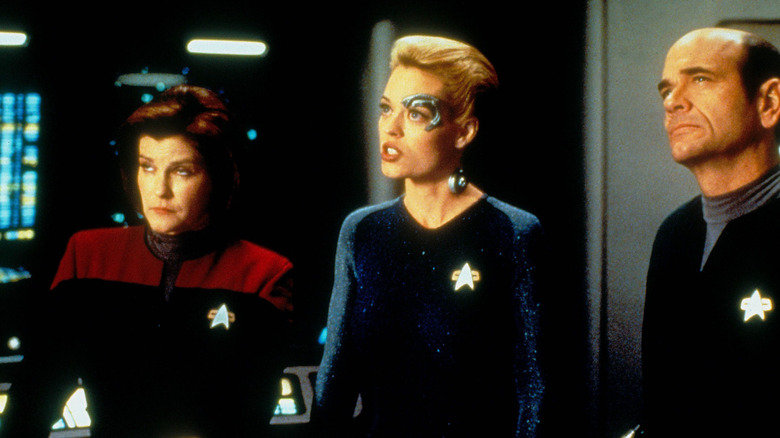
The showrunner of the third season of "Star Trek: Picard," Terry Matalas, began the season with a few cute references and cameos to whet the appetites of nostalgia-hungry Trekkies. One of the first shots of the season was a slow pan over the belongings of Dr. Crusher (Gates McFadden), and sharp-eyed fans would likely recognize several trinkets and pictures and audio logs left over from "Star Trek: The Next Generation." For five episodes, Matalas played light and fair with additional nostalgic references, focusing instead on new characters, a new ship, and the story at hand.
In the back half of the season, however, the dam burst, and the cameos and references began coming fast and furious. There were small notable roles for Ro Laren (Michelle Forbes), Tuvok (Tim Russ), and Commander Shelby (Elizabeth Dennehy). The eighth episode saw the entire central cast of "Star Trek: The Next Generation" in the same room at the same time, and it was revealed that the Borg were once again the villains of the piece. The final episode of the series, called "The Last Generation," featured an audio cameo from Walter Koenig, playing Anton Chekov, the son of Pavel Chekov. And, of course, the finale centered the Enterprise-D, the ship that was destroyed in "Star Trek: Generations."
In a roundtable discussion, attended by /Film's own Vanessa Armstrong, Matalas revealed that he actually wanted to cram in even more references and cameo appearances. He mentioned that he wanted justice for Harry Kim, the eternal ensign, by giving him a captaincy. He also wanted to establish that two characters, presumed dead or imprisoned, were alive and well, and he wanted a cameo from the first two seasons of "Picard." Notably, he wanted an on-camera appearance from Admiral Janeway (Kate Mulgrew), the captain of the U.S.S. Voyager.
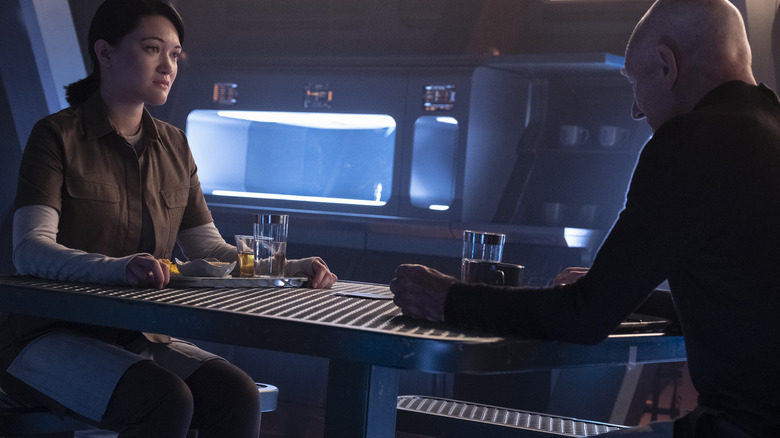
The reason he couldn't have the cameos, Terry Matalas said, was an issue of both budget and of scheduling. Getting all his intended actors in the room at the same time would have been a logistical nightmare, and not everyone he wanted was available during the "Picard" shooting window. Additionally, he noted that Paramount didn't have the budget to pay all the actors in question; it seemed getting the "Next Generation" cast back was expensive enough. He also wanted to link this season of "Picard" -- which largely stands apart from the previous two seasons -- back to the first. It seems Soji (Isa Briones) was a part of Matalas' original ideas. He explained:
"[T]here were characters I really wanted to see again. In the original finale script ... look, it was a giant movie that we were building on a television time schedule. The fact that you saw what we saw was miraculous that we pulled it off. It nearly killed us all. But there was a scene with Soji and Data that we could not afford to do. And another actor."
Matalas was coy about who "another actor" might have been.
Soji, for those who forgot, was a central character in the early episodes of "Picard." It seems that a Federation scientist salvaged a particle of Data's android brain, left exploded after the events of "Star Trek: Nemesis." Someone then essentially "cloned" Data from the particle, not only re-growing his consciousness and memories (!), but also creating a pair of organic android twins. Even for "Star Trek," the pseudoscience was far-fetched, but it resulted in a character, Soji, who found herself struggling with the revelation that she was an artificial being with false childhood memories.
Because she is technically Data's daughter, Matalas wanted Soji to meet Data.
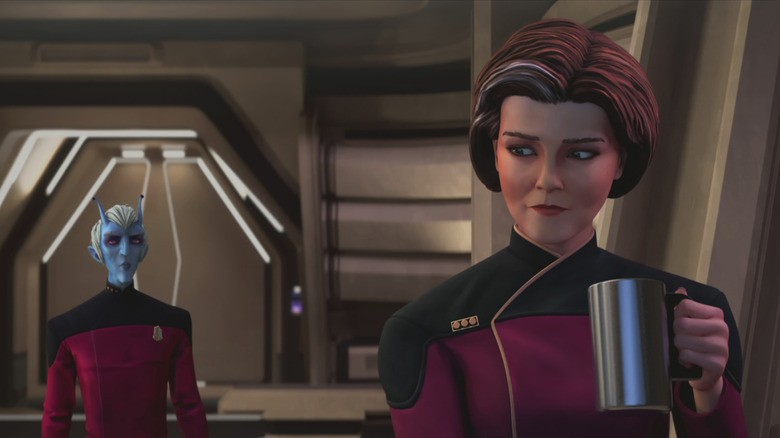
At the end of "The Last Generation," Seven of Nine (Jeri Ryan) is recommended for a promotion to captain. Terry Matalas wanted an additional Starfleet officer present for her promotion, an officer that Seven served with for many years aboard the U.S.S. Voyager. Yes, Matalas wanted Admiral Janeway to be there. He also mentioned that he wanted to resurrect Tuvok and Ro and Harry Kim. Sadly, none of this was in the budget. In his words:
"Ro, there was a scene in which they found Ro Laren in the dungeons of the Intrepid with Tuvok, and that she had survived. We weren't able to pull off. Harry Kim had appeared at one point. We really wanted to bring back ... we wanted Kate Mulgrew to be part of Seven of Nine's promotion. These are all things that ... they're all in the first script, and then your line producer says 'Are you out of your f***in' mind? You can't afford these things. You are not 'Avengers: Endgame.'' So they got to go away. And so those are our regrets. But I'm very happy with what we were able to pull off."
While a scene between Mulgrew and Ryan would have pleased the many "Voyager" fans, it should be noted that modern "Trek" is not absent Captain Janeway. The character appears -- in two different forms -- on the animated series "Star Trek: Prodigy." One version of Janeway is an instructional hologram that constantly instructs and subtly mothers a crew of non-Federation teenagers. Later in the series, after the teens manage to fly their ship into the outer edges of Federation space, they run into the real Janeway, now grumpy after switching from coffee to tea.
She might not have been in "Picard," but she is present in "Trek."
Read this next: Every Star Trek Show And Movie In Chronological Order
The post A Major Star Trek: Voyager Cameo Didn't Make the Cut For Picard Season 3 appeared first on /Film.
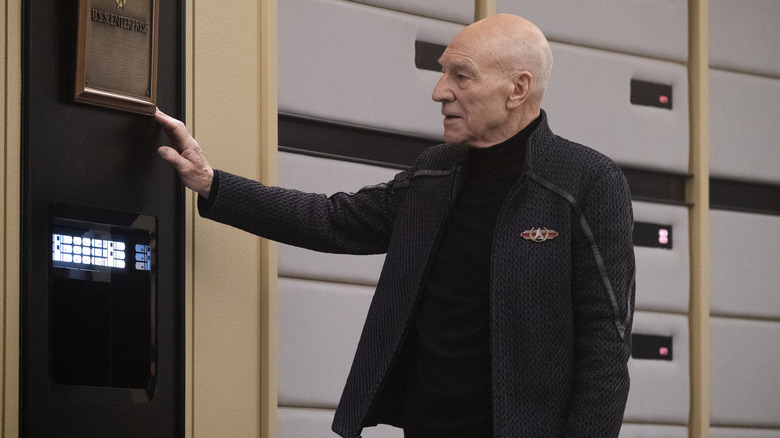
This article contains spoilers for the series finale of "Star Trek: Picard."
"Star Trek: Picard" season 3 showrunner Terry Matalas wants to continue the story in a spin-off series, potentially called "Star Trek: Legacy," and he's already full of ideas on how to pull it off. At a press roundtable attended by /Film's Vanessa Armstrong, Matalas revealed that while one fan-favorite character died during the course of "Picard," he has a pretty neat idea on how to potentially bring them back in the future. As far as we can tell, "Legacy" would follow the crew of the U.S.S. Enterprise-G, including Captain Seven of Nine (Jeri Ryan), Number One Raffi (Michelle Hurd), and Special Counsel to the Captain, Jack Crusher (Ed Speelers), who would have to negotiate the strange new world of life in Starfleet after the Borg event that nearly wiped out the Federation.
There's just one problem: Starfleet's most curmudgeonly captain isn't around to see this future he helped create, and that's a major bummer. Fans had such a great time getting to know Todd Stashwick's Captain Shaw that killing him off in "Picard" felt like a waste of a wonderful character, but apparently Matalas has a plan to maybe bring him back. I don't know about you, but I'll watch any "Star Trek" that features my favorite dips*** from Chicago, so I hope Matalas can make it work.
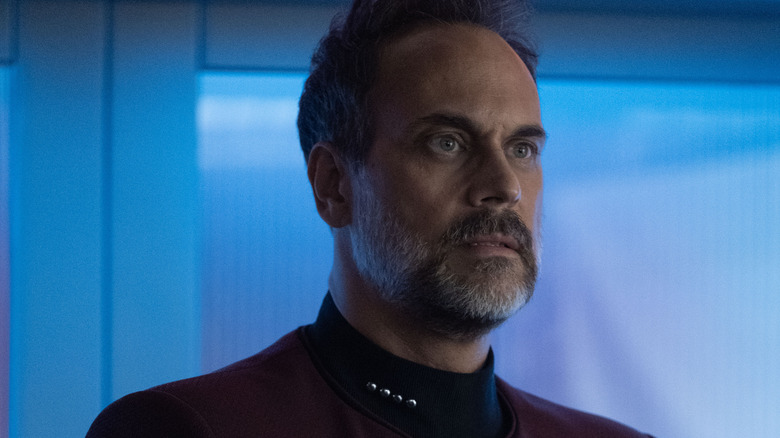
When asked about Shaw's fate and whether or not he was always supposed to die in "Picard," Terry Matalas explained that the character was a sacrificial lamb from the beginning, with a clue in his very name:
"No, he was always supposed to die. [...] It was always his arc. He's named Shaw after Robert Shaw in 'Jaws.' He was going to get eaten by the shark. He was going to be killed by the Borg. That was always a very, very simple story. It was part of his fate."
That makes a lot of sense, especially given that this Shaw had his own version of the classic "U.S.S. Indianapolis" monologue from "Jaws," but it's still a pretty major bummer. Apparently what the crew behind "Picard" season 3 hadn't anticipated was just how much the fans would love Shaw, as the character became a fan-favorite pretty quickly. What's not to love about a no-nonsense Starfleet captain who's willing to stand up to titans of the Federation in the name of what he thinks is right? Sure, he's a little racist against the Borg in the beginning, but no one's perfect and he was working on that! Matalas attributes Shaw's surprising success with the fans to the writing team and Todd Stashwick's charisma, making the character so much more than just a simple grumpy Gus. The role was even "tailor-made" for Stashwick after he and Matalas worked together on "12 Monkeys," and it would be fun to see them work together again on "Legacy."
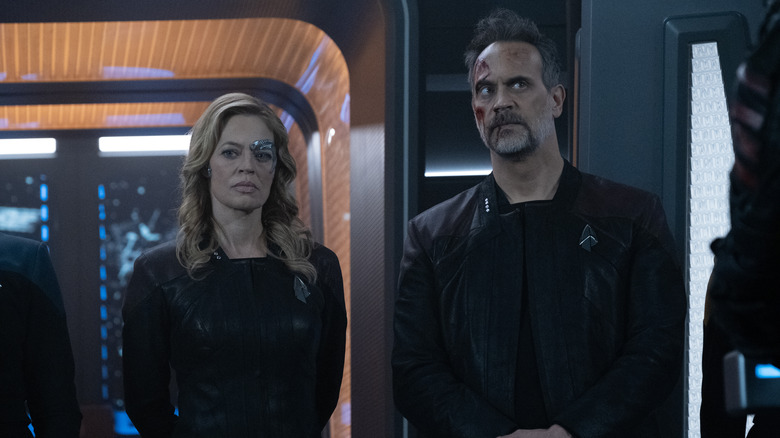
Todd Stashwick and Shaw both rule, and "Star Trek" fans want more! Thankfully, Terry Matalas also revealed that there's a plan in place to bring Shaw back if they manage to get "Legacy" off the ground and decide to resurrect the cantankerous captain:
"We knew from minute one there is a way for Shaw to return in the most wonderful way, that's not a cop out, if we ever were to come back and it's awesome. Awesome."
There are a lot of different ways for characters to return from the dead in the "Star Trek" franchise, ranging from deeply scientific to totally fantastical. There could be a Shaw clone or android, for example, or the franchise's main mischief maker, the god-like Q (John de Lancie) could play with the nature of reality to bring him back. Honestly, the whole idea of bringing Shaw back from the dead after everything he went through is darkly hilarious and fits the character's arc pretty well, forcing him back into the line of duty when all he wants is a break. If that's not relatable, I don't know what is. We'll have to wait and see what happens when it comes to "Star Trek: Legacy" and Captain Shaw's role in it, but I'll be keeping my fingers crossed for this jazz-hating sass machine to return.
The entirety of "Star Trek: Picard" is available to stream on Paramount+.
Read this next: Every Star Trek Show And Movie In Chronological Order
The post Star Trek: Picard Showrunner Knows a 'Most Wonderful' Way to Bring One Character Back From the Dead appeared first on /Film.
Today, T-Mobile announced its latest Un-carrier event, with the carrier intent on bringing more disruption to the wireless industry. In a time when three year wireless plans through EIPs (equipment installation plans) are becoming more common, the carrier is rolling out 'Phone Freedom' with a three-pronged approach that includes Go5G Plus, The Easy Unlock, and the Go Back Guarantee.
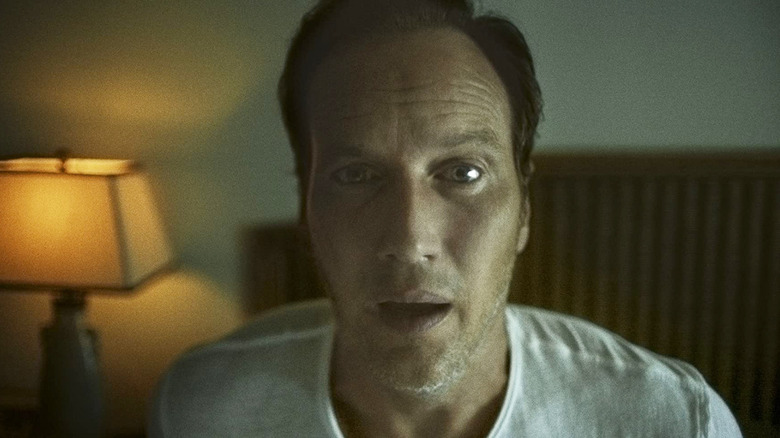
The demonic daytime scares of the "Insidious" franchise are back for a fifth installment, "Insidious: The Red Door," due out in theaters on July 7, 2023. In 2011, James Wan's ("Aquaman," "Malignant") original film proved that a PG-13 horror movie could actually be scary, mostly thanks to the toothy grin of The Lipstick Face Demon that terrorized the Lambert family.
In "Insidious: The Red Door," the story picks up 10 years after the events of "Insidious: Chapter 2," with Josh and Renai (Patrick Wilson and Rose Byrne) getting ready to send their now adult son Dalton (Ty Simpkins) to art school. Dalton is still dealing with the psychological effects of combatting supernatural forces as a child, and his paintings seem to awaken the same forces that are determined to take over his body, mind, and soul.
This time around, Wilson is stepping behind the camera for the first time as a director, and filling the shoes of Wan and writer Leigh Whannell (who also directed "Insidious: Chapter 3") was a responsibility that weighed on Wilson at first. "I think I was scared of trying to fit in James' shoes and Leigh's and gosh, the comparisons," Wilson told IGN. "My fear of wanting to step into this genre and specifically back into the 'Insidious' world and take the reins, it lasted about 24 hours."
Having Wilson direct this next adventure into the paranormal realm of The Further has a certain symmetry to it, and keeps everything in the family, so to speak. The fact that Simpkins is also returning to the role of Dalton -- the same part he played as a young boy over 10 years ago -- also feels like a homecoming of sorts for the franchise.
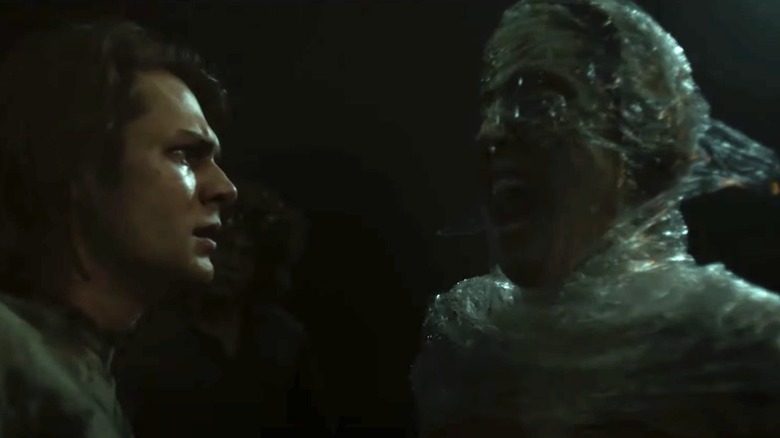
You may be done with the past, but the past isn't done with you. That nugget of wisdom is never more true than it is for tormented families trapped in a horror franchise that won't let them find any peace. Catching up with the timeline in the present day, "Insidious: The Red Door" creaks open to unleash the same entities that have now invaded the lives of the Lamberts for a generation. When Patrick Wilson agreed to return as star and director, he wanted to explore the trauma inflicted in the earlier films and see if there was any potential for the family to weaponize the curse that's followed them around for over a decade. He explained to IGN:
"I wanted to unpack everything that happened at the end of 'Insidious 2.' I really wanted to finish this Lambert trilogy and I wanted to, again, without giving the storyline away, I wanted to push this generational curse even more. What does that mean? When does a curse become a blessing? Is a blessing a curse?"
Previously, the Lamberts have been hypnotized, comatosed, and terrorized during their efforts to rid themselves of that family curse. What kind of damage does that do to a family over time? That's a compelling place to start for a father-son relationship that has to pick up the pieces and then suddenly deal with a new threat. Although now, Dalton is an adult who can fend for himself and may not need the protection of his family. In fact, the family may only make things worse. Those are potentially some heavy hitting issues that Wilson and screenwriter Scott Teems ("Halloween Kills") wanted to explore.
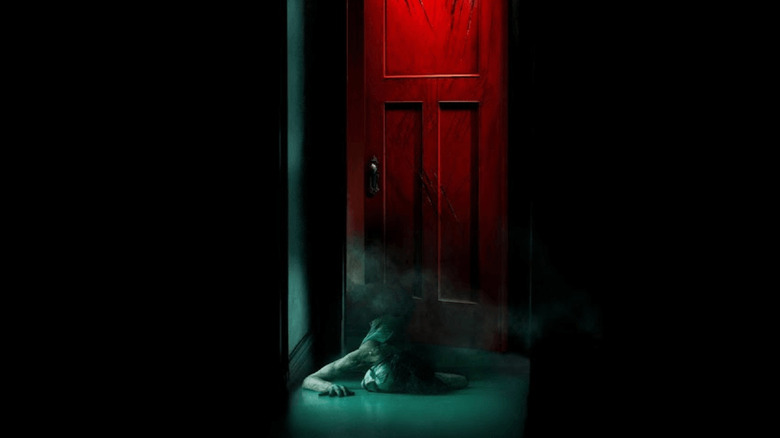
Patrick Wilson seems to have every confidence that he can deliver a frightening and worthy follow-up to one of the most successful horror franchises in recent memory. What made the original "Insidious" so effective was largely due to director James Wan and scribe Leigh Whannell who managed to turn the genre on its head with fresh, exciting ideas and new ways to deliver the classic jump scare. Wilson was determined not to move too far away from what Wan and Whannell first envisioned back in 2011, telling IGN:
"I wanted to take all these little breadcrumbs that James had left along the way and [ask] what does that do to a kid in college? I just dove in from there and the generational curses and giving to the relationship of father and son and what that does to their relationship and the aftermath of what happened in 'Insidious 2.'"
Wilson has always been a student of film and has never shied away from the horror genre, appearing in multiple installments of "The Conjuring," the Stephen King adaptation "In the Tall Grass," and now, another go around inside the treacherous world of "Insidious." Of course, these properties have been hugely successful, but that's not the only reason Wilson keeps coming back for more scares. "You're dealing with a lot of very heavy subjects, but there's really no better genre to explore that than horror because it really becomes very operatic," explained Wilson. "That's what I love about horror."
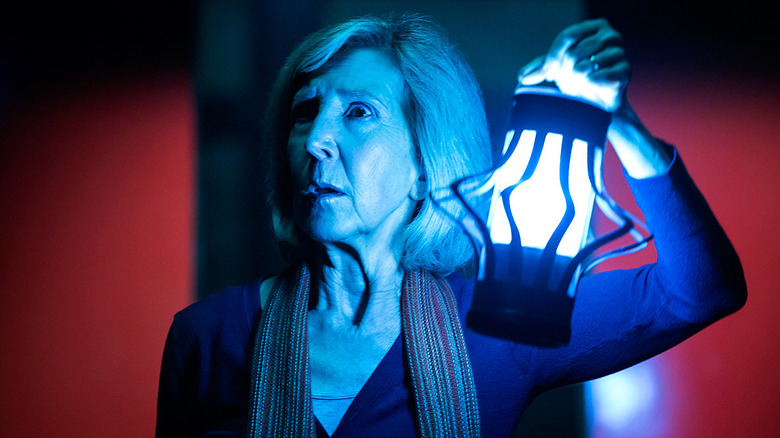
Over the last few entries of the "Insidious" franchise, the timeline has gotten a little confusing, admittedly. Luckily, acting powerhouse and genre staple, Lin Shaye is here to light the way out of The Further and get you back home in one piece. In the original film, Shaye is introduced as a compassionate psychic medium named Elise Rainer, who descends upon the Lambert household, along with her ghost-busting cohorts Specs (Leigh Whannell) and Tucker (Angus Sampson), to gather evidence of the paranormal and help exorcise whatever evil spirits are lurking around. Tragically, Elsie dies in the first film, but due to some clever writing and flashbacks, she reappears in "Insidious: Chapter 2" in a somewhat derivative sequel. At this point in the series, the timeline is mostly intact.
Shaye then returns front and center in "Insidious: Chapter 3" which serves as a prequel and origin story for Elise that takes place a few years before the first film. In "Insidious: The Last Key," Shaye stars in yet another prequel that takes place in 2010 (with flashbacks that explore Elise's abusive childhood in the 1950s). Then, the ending of "The Last Key" pulls a "Rogue One" and leads right into the events of "Insidious."
With that all laid out, in preparation for "Insidious: The Red Door," and to enjoy the maximum dose of Lin Shaye, here's the correct chronological order to watch the series: "Insidious: Chapter 3," "Insidious: The Last Key," "Insidious," "Insidious: Chapter 2," and finally, "Insidious: The Red Door."
And not to worry: Lin Shaye appears in the trailer for "The Red Door" on what appears to be an old video recording, So rest assured, Elise's story will continue on for at least one more film.
Read this next: The Saddest Character Deaths In Horror History
The post Patrick Wilson Wanted to Continue the Original Insidious Storyline With The Red Door appeared first on /Film.
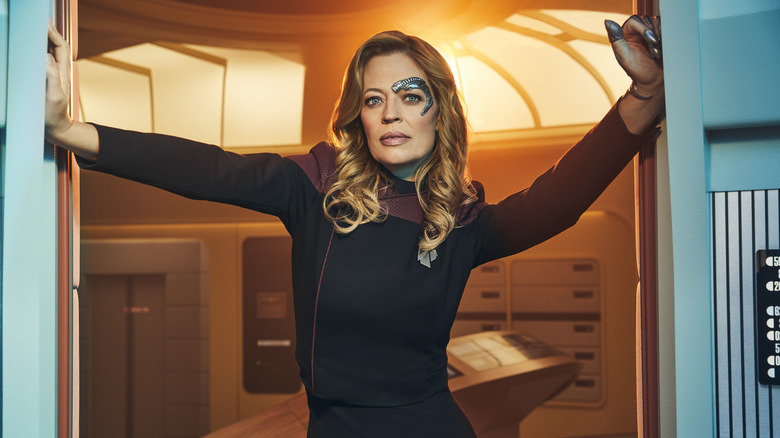
This post contains spoilers for the series finale of "Star Trek: Picard."
Season 3 of "Star Trek: Picard" was largely about legacy, so it's no surprise that showrunner Terry Matalas wants to create a spin-off series called, well, "Star Trek: Legacy!" The series isn't official and hasn't been confirmed, but Matalas has said it's within the realm of possibility if enough people tune into "Star Trek: Picard" to justify another series. It's all up in the air and a matter of conjecture, but there has been some fan desire for a spin-off featuring Seven of Nine (Jeri Ryan) and Captain Shaw (Todd Stashwick), so who knows?
Matalas made sure to lay the groundwork for a potential spin-off in the series finale of "Star Trek: Picard," setting up a show that would follow the next crew of the shiny new Enterprise, the Enterprise-G. Helmed by Captain Seven of Nine (Jeri Ryan), the ship could boldly go once more. The third season of "Picard" was quite a ride, giving fans a nice goodbye to the characters of "Star Trek: The Next Generation" while also introducing us to the next next generation, like Jack Crusher (Ed Speelers) and Sidney La Forge (Ashlei Sharpe Chestnut). If "Star Trek: Legacy" is as compelling as "Picard," it could be one heck of a show.
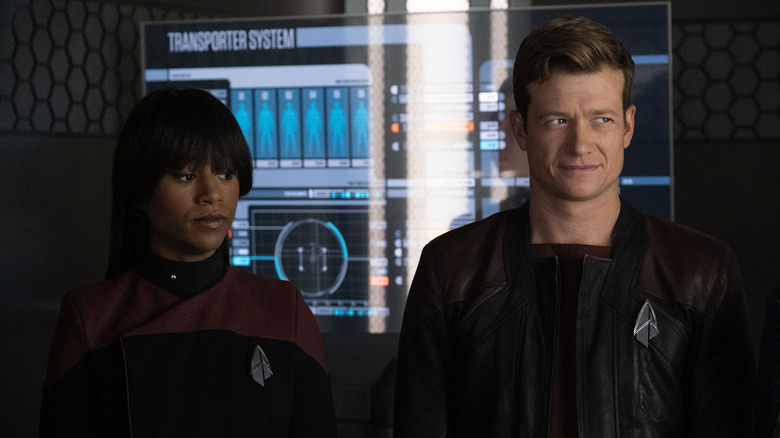
In the finale of "Picard," Seven of Nine tries to resign from Starfleet after the horrors of fighting the Borg queen and the Changelings, but Tuvok (Tim Russ) refuses her request and instead gives her a promotion and a new assignment. Based on the recommendation of the late Captain Shaw, who is apparently dead for good after being mortally wounded on the bridge of the U.S.S. Titan, Tuvok gives her command of the Enterprise along with a crew of familiar faces. Her No. 1 is none other than her ex-girlfriend Raffi (Michelle Hurd), while Jean-Luc Picard and Beverly Crusher's son, Jack Crusher, will be her special counsel. Ace pilot Sidney La Forge, daughter of Geordi La Forge (LeVar Burton), will serve as the ship's pilot. Other members of Seven's previous crew on the Titan are there as well, and there's always potential to bring back some of the other characters from "Picard." Worf (Michael Dorn) could drop in to check on Raffi, Geordi could always show up to say hello to his daughter, and who knows — we could even see Gates McFadden show up as Beverly again because of Jack's role in things. (Also, she's interested!)
There's a long history of the children of Starfleet officers going into Starfleet themselves, and there's no shortage of nepotism babies across the franchise, but it will be interesting to see how "Legacy" would contend with featuring the children of Picard, Crusher, and La Forge without relying too heavily on their parents' exploits. The good news is that Jack and Sidney have great chemistry and a potential romantic arc, which could be a lot of fun to explore.
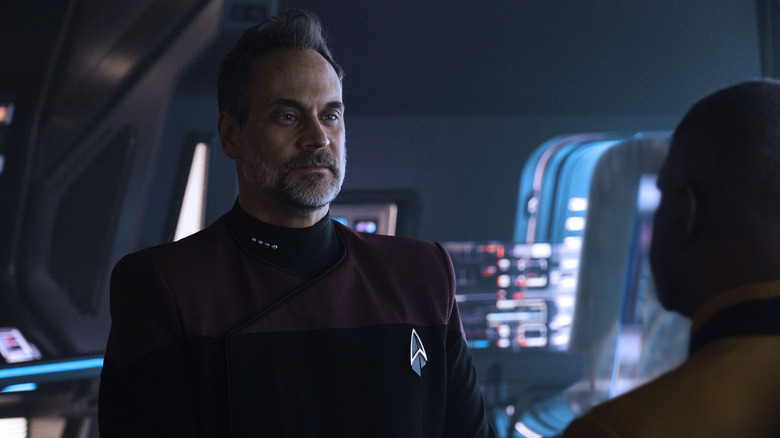
Poor Captain Shaw died doing what he hated (putting up with the nonsense of the Enterprise crew), and it's a real shame that he's not going to be able to join Seven of Nine on a potential "Legacy" show. The two had a fantastic back-and-forth on the Titan in "Picard" and were a big highlight of the season. It would have been fun to see how their relationship changed now that Seven seems to have earned Shaw's respect. Shaw is pretty darn dead, however, and the events of the "Picard" finale seem to cement that he's dead for good. But this is "Star Trek," after all. How many times has Data (Brent Spiner) died now, again? It's extremely unlikely that Shaw uploaded his consciousness anywhere to be put into one of Dr. Soong's fancy new bio-android bodies like Picard, but there is one potential avenue for Shaw to return, and it showed up in the post-credits sequence.
Q (John de Lancie), the interdimensional trickster god of "Star Trek," is apparently back, appearing in the credits sequence after everything was neatly wrapped up on "Picard." He shows up to talk to Jack, essentially revealing that he's going to be bothering the Picard bloodline for all of eternity and that his "death" in season 2 wasn't all that permanent. While bringing Q into "Legacy" feels a little silly, it would be one way to get ridiculous with things and potentially undo any canon that restricts moving forward, like bringing Shaw back to life! Besides, there's nothing funnier than Shaw finally getting a break from adventures, only to be brought back into an even more ridiculous adventure. Hire me, Mr. Matalas!
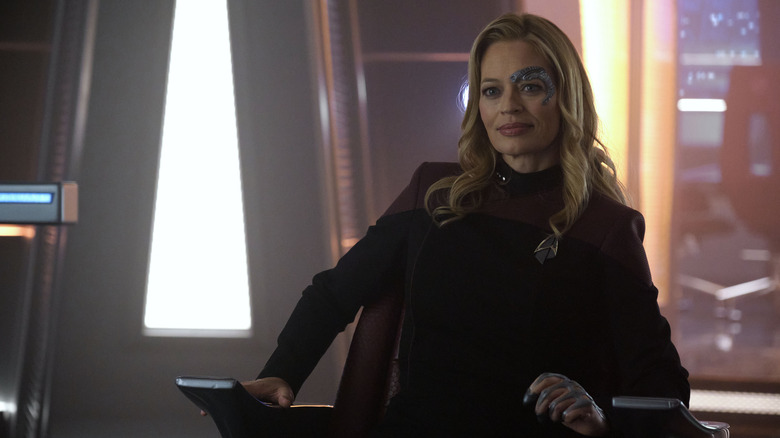
Seeing Seven of Nine at the helm of her own ship was a wonderful moment for any fan who has followed her from her earliest days on "Star Trek: Voyager," and it would be a blast to see how she handles leadership with such an interesting crew. After all, her second-in-command is her ex-girlfriend and that alone makes things complicated. Add in the fact that Jack just went from being Picard's son-on-the-run to some kind of Borg Antichrist and now he's just Jack again, and you've got worlds of built-in drama. There's also the idea that this truly is a new era for Starfleet following Jack and the Borg's psychic possession of all of the young Starfleet crew members and the subsequent events, because they're going to have to start anew. There were serious casualties, and the flaws in Starfleet were laid bare, which means they will have to rebuild stronger than they were the first time around.
Right before the maiden voyage of the Enterprise-G, Riker refers to the date as "Stardate 1," insinuating the epic scale of both the Borg event and everything going forward. When Seven is ready to take the ship out of space dock, Raffi and Jack ask her what her definitive commanding phrase will be, referencing Picard's "Engage" and a list of other Captain catchphrases. Right before she says it, however, the camera cuts away. Talk about a cliffhanger! The whole scene sets up the central themes for "Legacy" and a taste of what the show could feel like, leaving fans content with the endings for "The Next Generation" crew but still wanting more. Let's hope it happens.
All three seasons of "Star Trek: Picard" are now streaming on Paramount+.
Read this next: Every Star Trek Series Ranked From Worst To Best
The post The Picard Series Finale Leaves the Door Wide Open for Star Trek: Legacy appeared first on /Film.
In November 2019, we shared a fan remake of Sonic 2006 in Unity Engine, called Project ’06. And today, we are happy to report that a brand new version of it is available for download. According to the developers, this is the third installment of Project ’06’s episodic releases and the full release of Silver’s … Continue reading New version released for the Sonic 2006 Fan Remake, Project ’06 →
The post New version released for the Sonic 2006 Fan Remake, Project ’06 appeared first on DSOGaming.
A couple of days ago, the “GB_2 Development Team” released the seventh major update for its NoVR Mod for Half-Life: Alyx. This new patch comes with a lot of bug fixes and introduces some new features that we’ll detail below. Update #7 updates more ladders with a new animation. And while this is great news, … Continue reading Half-Life: Alyx NoVR Mod Update #7 is available for download →
The post Half-Life: Alyx NoVR Mod Update #7 is available for download appeared first on DSOGaming.

A new update has gone live for Death Stranding Director's Cut, the definitive edition of the first game developed by Kojima Productions, introducing support for the latest version of Intel XeSS, as well as DualSense Edge support and more.
The new 5 GB big update, which went live yesterday, introduces support for Intel XeSS 1.1, which brings improved temporal stability for XeSS DP4a and XMX models. Additionally, the update reduces ghosting, moire, and flickering for better visuals as well as DualSense Edge support. To use the full functionality of the controller, players will need to disable Steam Input and connect the controller with a USB C cable.
Following the release of Death Stranding Director's Cut, Hideo Kojima and his team announced a direct sequel to the game, which is apparently releasing sometime in 2024. The story of the next entry in the series, which Kojima himself said wouldn't be a regular sequel, was completely rewritten following the pandemic, as a story written before that experience wouldn't have resonated well with players.
Alongside a new entry in the series, a Death Stranding movie adaptation is also in the works. Hideo Kojima received a lot of offers but ultimately settled with Hammerstone Studios' Alex Lebovici, as he was the only one that offered to make a movie with a more artsy approach. Not a whole lot was decided on the movie in late 2022, but what Kojima is set on doing is to take the movie in a direction that no one tried before when it comes to movie adaptations of video games.
Death Stranding Director's Cut is now available on PC and PlayStation 5 worldwide. You can learn more about the original release by checking out my review and about the Director's Cut by checking out Kai's review.
Last week, we informed you about a bug that disabled the ray tracing settings from the PC versions of Resident Evil 2 Remake and Resident Evil 3 Remake. And today, Capcom issued a new update that restores these RT options on PC. Update for Steam users: A patch for the missing raytracing options should now … Continue reading Capcom restores the missing Ray Tracing options from Resident Evil 2 Remake & Resident Evil 3 Remake →
The post Capcom restores the missing Ray Tracing options from Resident Evil 2 Remake & Resident Evil 3 Remake appeared first on DSOGaming.

Jon Peddie Research recently reviewed GPU sales data, graphics card segmentation, and Steam's Hardware Surveys to find that enthusiasts & gamers prefer playing games on desktop PCs instead of notebooks.
Jon Peddie Research is a technically oriented multimedia and graphics research and consulting firm with a keen eye on the technology field for over thirty years. In the research firm's newest data analysis on the PC gaming marketplace, the company noticed that 87% of gamers prefer to use desktop gaming computers instead of highly publicized gaming notebooks.
But why does the sales data show an increase in gaming laptops? JPR explains that gaming notebooks may not be used to play games but are used for other categories. In their recent report, the firm analyzed Steam's Hardware survey that split graphics cards into three categories — desktop, notebook, and either.

The "Either" category is used to place GPU configurations that could show up on desktops or laptops. Still, a fourth category, "unknown," is also in the analysis, albeit with a small two percent of users surveyed.
Valve's Steam survey showed that desktop GPU configurations were tallied by 68% of users, while 10% were notebook graphics. The remaining 20% was placed in the "either" category, making it difficult to tell the exact configuration used.
JPR's methodology to understand the realistic number of desktop GPUs to notebook GPUs using the other two categories showed that 87% of users are playing on desktop PCs. In contrast, 13% of users are most likely playing on notebooks. Desktop computers offer much more customization features compared to laptops and are more affordable. This would explain why desktops would be preferred over notebooks for PC gaming.
The research firm continues explaining that PC manufacturers review SKUs and "branding-level data and non-market representative internal sales data" when analyzing what products are selling and what they should focus their manufacturing on to acquire the most sales figures. However, the data can fool even the top companies, as users may not purchase a gaming notebook specifically for gaming but for other purposes, such as design, programming, finance, and more, especially when the systems are highly optimized with components that offer the most performance for the cost. However, you also have users that purchase gaming notebooks for looks, similar to someone buying a high-end and flashy car to impress others and to fit a specific look for their gaming setups.

JPR feels that companies should reanalyze the use of the products currently on the market so that manufacturers can invest in systems serving the intended purposes & better market for those PCs.
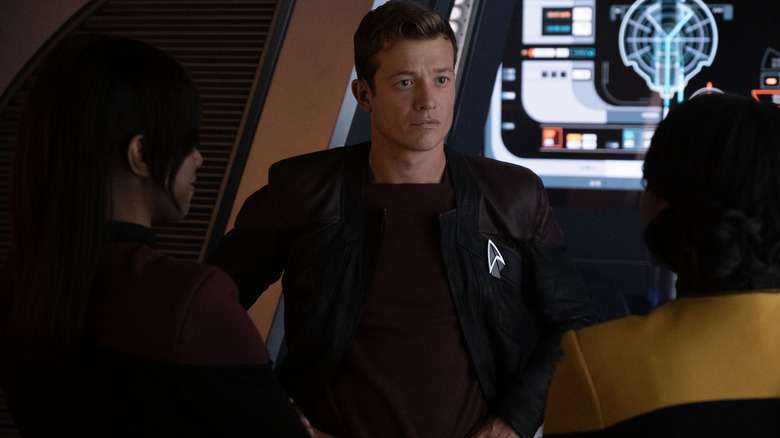
This post contains spoilers for the series finale of "Star Trek: Picard."
The third season of "Star Trek: Picard" was long ago declared to be its last. Lead actor Patrick Stewart is hanging up his communicator and the cast of "Star Trek: The Next Generation" will finally split up for good. The final season of "Picard" largely served as their encore, a late-in-life reunion that allowed the character to have a few conversations -- and to be in utter peril -- one last time. It seems the Next Generation is no longer their generation.
Indeed, "Picard" ends with a Next Generation of its own. Flashing forward to a year after the season's climactic Borg battle, a new crew has been assembled. Sidney La Forge (Ashlei Sharp Chestnut), the daughter of Geordi La Forge (LeVar Burton), is already sitting at the helm of the U.S.S. Titan-A. Jack Crusher (Ed Speleers), the son of Jean-Luc Picard (Patrick Stewart) and Dr. Crusher (Gates McFadden), has passed through Starfleet (in only one year!) and will sit as the special counselor to the captain of the Titan. The captain, incidentally, is Seven of Nine (Jeri Ryan) and her first officer will be Raffi (Michelle Hurd), her one-time girlfriend. This is "Star Trek: The Next, Next Generation."
Also, to assure that legacy is on everyone's mind, the U.S.S. Titan is, at the last minute, rechristened the U.S.S. Enterprise-G (it seems that the Enterprise-F was wiped out quickly). Jack will begin his career on the namesake ship of his father's two most famous commands.
With the circumstances so arranged, naturally, the showrunners decided to fold in one last notable guest star to link everything back to NextGen. In a mid-credits scene, the presumed-dead trickster god Q (John de Lancie), alive again, appears to Jack.
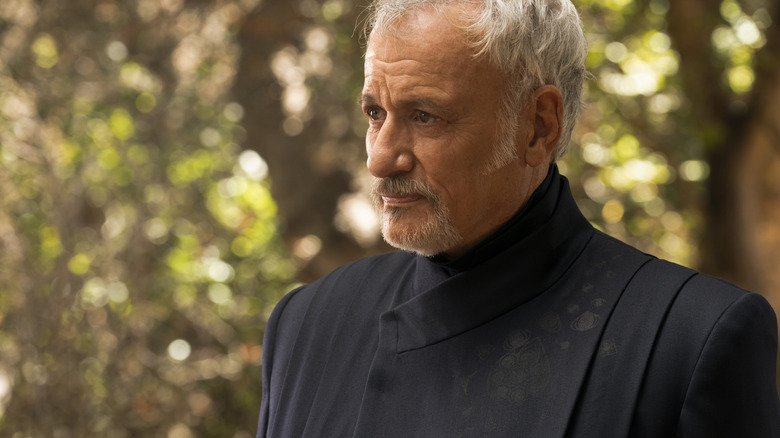
Q died during the finale of the second season of "Star Trek: Picard." So how can he be back to wreak inconvenience on Jack Crusher? Seeing as he is an omnipotent being that lives beyond the normal laws of time and space, there's no reason why he couldn't have lived another several billion years, only to return to the time when Jean-Luc Picard was alive to bid him farewell. He explains to Jack that humans think in linear terms and that his death was not to be taken as permanent.
Jack tells Q that he knows all about his appearances to Jean-Luc, and how Q infamously put humanity on trial for their aggression and brutality. Q first appeared in the "Next Generation" pilot episode "Encounter at Farpoint" (September 28, 1987) dressed as a post-apocalyptic judge in control of his own kangaroo court. In the show's final episode, "All Good Things..." (May 23, 1994), Q declared that the trial never ended and that Picard, through his own witlessness, will accidentally destroy humanity. It wasn't until Picard could understand the real existence of paradoxes that humanity began to show a glimmer of promise. Q withdrew, having proven his point.
Q would return a few times on "Star Trek: Deep Space Nine" and "Star Trek: Voyager," and would close out his story in "Picard," hugging Jean-Luc in a bizarrely sentimental farewell. It seemed that his infinite lifecycle came to an end.
But, as audiences now see, the trial seemingly continues in perpetuity. Q says to Jack that his own trial is just starting. Picard's progeny now bears the responsibility of proving humanity's worthiness to continue existing.
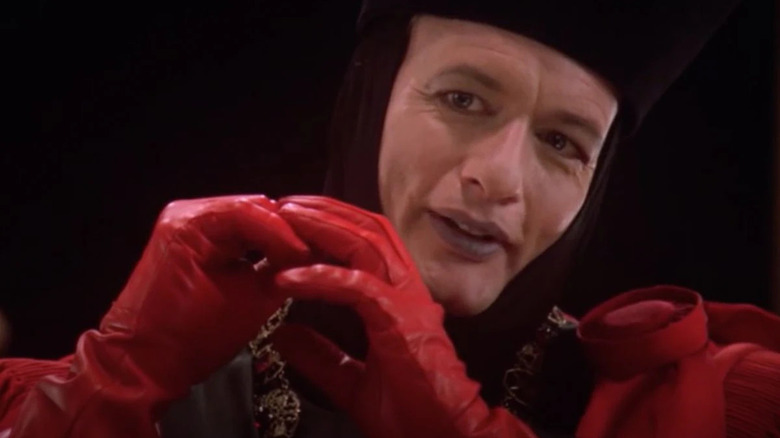
Audiences have long been trained to accept mid-credits teasers as previews for an upcoming film or TV series; we have the Marvel Cinematic Universe to thank for that. As such, the appearance of Q might serve as a miniature pilot for another new "Star Trek" TV series. Showrunner Terry Matalas has even said that he would love to make a series called "Star Trek: Legacy," which would presumably be about life on the Enterprise-G with a young ensign Crusher and Captain Seven seeking out new life and new civilizations.
With a new Enterprise, a new crew, and a godlike antagonist, it seems that we're exactly back to where we were in 1987 with the launch of "Next Generation." Only this time, a whole season of television presaged it, establishing characters and scenarios the way a pilot episode might. The groundwork has been laid. It seems all Matalas needs is a green light.
As for reusing the "Next Generation" premise of a Picard standing in as humanity's avatar while Q puts our species on trial, I have no problem. Repeating an idea may be cheap from a writerly perspective, but it makes logical sense given Q's nature. He is pretty much immortal, we see, and experiences time on a vast scale. When one can live billions of years, a millennium is but a drop in the bucket. Q knew Picard for, what, five decades? That's not even the single beat of a bumblebee's wing to Q. It makes sense that the trial of humanity would continue into the next generation, or even into multiple generations beyond. Q is the Picard family Devil now.
Whether or not audiences see it happening, we can rest assured that Q will make Picards miserable for thousands of years to come.
Read this next: 11 Reasons Why The Next Generation Is The Best Star Trek Show
The post Yep, the Picard Finale Has a Credits Scene, And We Need to Talk About It appeared first on /Film.

For better or worse, the formula of FromSoftware's Souls series has become so popular that it seems like every big or small development studio is trying to incorporate some of the franchise's key elements, such as challenging combat and environmental storytelling, in their games. While it is undeniable that these elements make for compelling experiences, their proper implementation is tricky, and only a few developers managed to create games that could rival the quality of FromSoftware's games.
With its bright and colorful setting, Point Blank's Stray Blade already set itself apart from the grim and dark competition and definitely had the potential to stand out from similar games thanks to much better accessibility and some unique combat mechanics, but unfortunately, their execution falls flat, resulting in a game that is way too often more frustrating than fun to play.

Unlike other games inspired by the Souls series, Stray Blade features a well-defined character called Farren. At an early age, they got a job as a translator on a trade ship, and since then, they became interested in learning more about the people of the world, so much they eventually became an anthropologist. Their studies of different cultures made them realize that three of them have claims on the valley of Acrea, which is where Farron eventually makes their way.
Acrea, however, isn't just any regular old valley that was contended by different groups for years. It is a magical valley where all those who set foot in it become immortal, at the cost of their freedom, as no one, once inside, is able to leave it. With no choice but to go forward, Farron starts exploring the valley, meeting the elementally enhanced half-wolf, half-Xhinnon being Boji, not knowing how the mystery behind Acrea is much deeper than they might have expected.
While action RPGs inspired by the Souls series are hardly focused on story and character development, Stray Blade offers a breath of fresh air in this regard. What is usually a lonely, silent journey through mysterious locations becomes something different in this game, as both Farren and Boji are extremely talkative, constantly providing new information not only on themselves but on the world they live in, the different people that populate it and the history of Acrea. At the end of the day, it is not anything particularly inspired. Still, it is undeniable that the development team put quite a bit of care into creating the setting and the lore, which is ultimately enjoyable if expectations are kept in check.
The Stray Blade setting and characters, however, are not enough to carry the whole experience. While some of the game's features sound interesting on paper, their execution ranges from flat to outright bad, resulting in an experience that is often not all that enjoyable.
Despite being labeled as an action role-playing game, the Stray Blade experience is more focused on action and combat rather than role-playing. Taking the stamina-based combat seen in the Souls series as the basis, the game builds upon it with some unique mechanics, such as perfect parries and perfect dodges mechanics. All enemies in the game are capable of unleashing different types of attacks that must either be parried or dodged, signaled by blue and red flashes, respectively. If a perfect parry is performed, the enemy will receive massive Poise damage, making it easy for Farron to deplete it completely and execute surprisingly gruesome execution attacks. On the other hand, if a perfect dodge is performed, Farron's energy will be restored, allowing them to go on the offensive using their equipped weapon's light, heavy or special attacks.

On paper, this creates a unique blend between the typical Soulslike combat and the parry systems seen in games like Sekiro: Shadows Die Twice, Wo Long: Fallen Dynasty, and even Stranger of Paradise: Final Fantasy Origin that should keep players always on their toes, but the execution of this blend is middling. For starters, while all attacks are signaled with the aforementioned colored flashes, their timing is all over the place, making perfect parries and dodges difficult to pull off if the player hasn't perfectly memorized the enemies' movesets. Even then, given how enemies rarely get staggered by Farron's attacks, defending properly all the time is difficult. It feels like the developers wanted to go for a system where players go from offense to defense on the fly, but for something like this, consistent timing between the attack indicators and the attacks themselves actually connecting with the player is even more of a requirement. Due to these issues, the decent enemy variety is a problem, as it just makes these gameplay mechanics feel more inconsistent.
Alongside these issues, there are a few more that make combat in Stray Blade more frustrating than it should have been. Stamina consumption for pretty much every combat action is way too high, resulting in getting it depleted way too often, even after upgrading the total amount. The clunkiness of Farron's movement and attacks, the general lack of weight, and the enemy's tendency to gang up on the player make matters even worse. All these issues somewhat render null some of the game's most unique aspects, such as the mechanics that make the world adapt to Farron's success in combat.
It is a shame that combat in Stray Blade is so unpolished, as the game does come with some interesting features that could have made it more dynamic and exciting. Farron's companion Boji isn't good at just talking but also learns some extremely useful combat abilities, such as a blast that depletes enemy Poise, which can be unleashed once a special gauge is filled up by fighting enemies. The game's weapon system is also tied to the character progression system, as nodes on the fairly straightforward skill tree are unlocked only once perfect mastery has been reached with any given weapon. While some players may see this as an annoyance more than a decent feature, as it essentially forces Farron to use all weapons to reach his full potential, I think this is a good way to make players experiment with different weapons and reward them in some way. Bosi also comes with his own skill tree, which requires players to obtain lore points from exploration, unlike Farron's, whose skill points are obtained by simply leveling up.
Exploration is another sore point for Stray Blade, possibly even more than the clunky combat, due to the bad level design. While they honestly don't look too bad, thanks to their colorful aesthetics which are reminiscent of games from the early 2000s, locations are designed in a terribly confusing way. It's almost as if the developers wanted to get as many alternate paths, crevices, caves, and enemy camps as possible, which only makes them hard to navigate without constantly using the compass and the map. And sometimes, even they complicate things, as maps must first be fully revealed by exploring the map and finding specific items, and the compass only indicates the general direction of the main quest objective. All these alternate paths aren't even justified by decent rewards, as what players will find, most of the time, are items used to craft armor and weapons.

Even crafting in Stray Blade feels terribly clunky, which is very surprising, considering how getting new weapons is so important to expand Farron's combat capabilities. Creating new gear can only be done by smithies once blueprints and all the needed materials have been obtained, but having to take out all enemies in their vicinities is not what makes the process clunky. However, after crafting any item and watching a small cutscene, players are not sent straight to the crafting menu but back on the field. It is a small thing, to be sure, but it's still a weird oversight. The game has a few more of these weird design decisions, such as respawning, which forces players to watch a short, unskippable cutscene of Boji bringing back Farren to the bonfire-styled checkpoints of the game.
All in all, the clunkiness of the experience suggests how Stray Blade needed more time in the oven, and the clear optimization issues are just another sign that the game needed more work. While the cartoonish visuals don't look too bad, giving the game, as already mentioned, an early 2000s feel, character models, locations, and lighting systems are far from looking demanding. This makes how the game ran on my system (i7-10700 CPU, RTX 3070 GPU, 16GB RAM) really baffling, as I was unable to get stable 60 FPS performance at 4K resolution even with AMD FSR on and some tweaking of the settings. Things did fare better at 1440p resolution with a smoother 100 FPS average at max settings, but still, a game like Stray Blade shouldn't have trouble running at 4K resolution on a system like mine, even without DLSS or FSR. The high system requirements hinted at something weird going on with the optimization, and unfortunately, that is indeed the case.
With the current flood of action role-playing games inspired by the Souls series, Stray Blade wasn't setting out to light the world on fire, but the game did have the potential to be much better than it turned out to be. While the experience isn't entirely unplayable when everything clicks together, the clunky execution of most of its gameplay mechanics makes it difficult to recommend the game to anyone but those who live and breathe ARPGs and need to play each and every one of them.
PC version tested. Review code provided by the publisher.
The Air Force is investigating how a lone airman could access and distribute possibly hundreds of highly classified documents, and in the meantime has taken away the intelligence mission from the unit where the leaks took place
The post Air Force Unit in Document Leaks Case Loses Intel Mission appeared first on SecurityWeek.
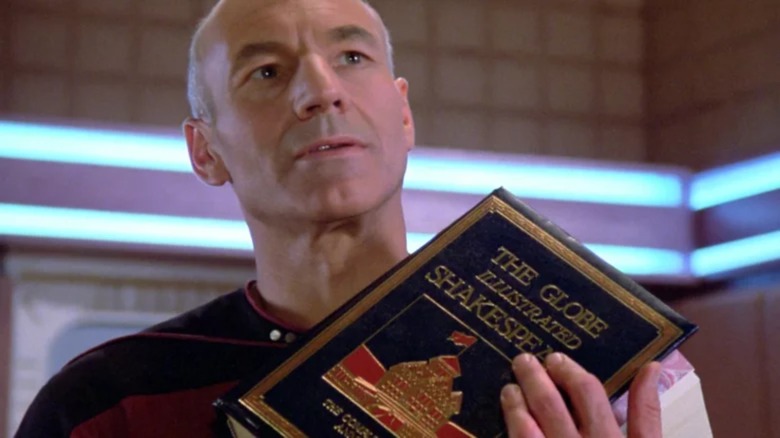
This post contains spoilers for the series finale of "Star Trek: Picard."
Throughout the final season of "Star Trek: Picard," Jean-Luc Picard (Patrick Stewart) is a man of surprisingly few words. Sure, the beloved retired captain chimes in with theories during the show's many exposition-heavy scenes, and has a few heart-to-hearts with his son Jack (Ed Speleers) and old pal Riker (Jonathan Frakes), but he's decidedly light on leaderly monologues. Picard is even fairly reticent when he's saying what may be one final goodbye to his crewmates, simply saying, "It means so much to me --" to Riker before parting ways.
I'll admit that moment in the finale had me yelling at the screen, hoping Picard would get the chance to say something, anything, that felt like a signature "Star Trek" sign-off before bowing out. I should've known the show was saving the best for last, and by best, I of course mean a signature Shakespearean interlude.
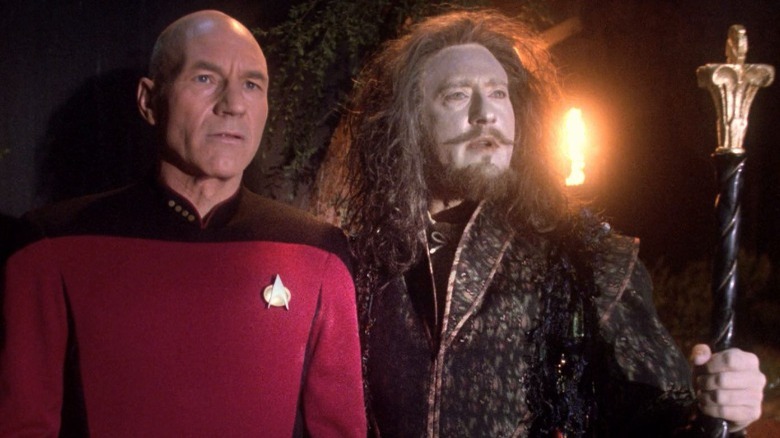
Jean-Luc Picard has been a fan of the Bard for pretty much as long as he's existed, thanks in large part to Stewart's own history with Shakespeare and the franchise's pre-existing literary streak. As The L.A. Times tells it, when Stewart was cast in "Star Trek: The Next Generation" in 1987, the outlet referred to him as an "unknown British Shakespearean actor." It was a superlative that stuck, as co-star Brent Spiner apparently had a sign made for Stewart's trailer door emblazoned with that exact phrase.
Soon, though, Stewart became extremely well-known, and his history on stage in Shakespearean productions became intertwined with the character he played in the much-loved series. Picard's first Shakespeare reference comes up in the very first episode of "Star Trek: The Next Generation," when he quotes "Henry VI, Part 2" in his first showdown with Q (John de Lancie). The works of Shakespeare appear again and again throughout the series, with both Picard and Data (Spiner) turning to the Bard's works as the key to understanding the whole of the human condition.
"Star Trek" has been obsessed with Shakespeare's works since long before Picard ever stepped foot aboard the Enterprise-D. Five different episodes of Gene Roddenberry's original series pull their titles from Shakespeare lines, including the fan-favorite time-travel episode "All Our Yesterdays," which references "Macbeth." Over the decades, the franchise's Shakespeare references have ranged from the silly (in one episode of "The Next Generation," the crew convinces a 19th-century Earth landlady they're traveling actors working on a production of "A Midsummer Night's Dream") to the insightful (in another, Picard uses Data's performance as Prospero to comment on art, hope, and despair). As "Picard" comes to an end, it lands its dismount with an especially heartfelt recitation.
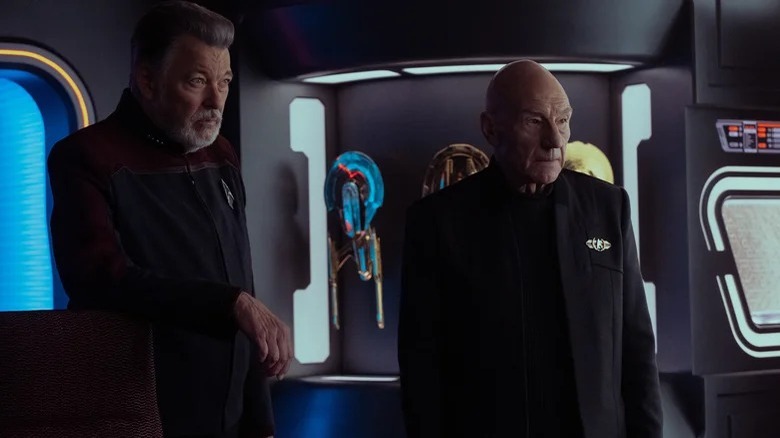
"There is a tide in the affairs of men/Which, taken at the flood/Leads on, to fortune. Omitted, all the voyage of their life is bound in shallows and in miseries/On such a full sea are we now afloat/And we must take the current when it serves/Or lose our ventures." – Brutus, "Julius Caesar"
In the final episode of "Star Trek: Picard," when the dust has settled and the Borg have been held at bay, Data passes over the honors of one last toast to his captain. In typical retiree-with-exactly-one-hobby fashion, Picard goes back to the works he knows best. With no ado but plenty of heart, he recites the above passage from "Julius Caesar" while his stalwart crew looks on, savoring the moment. When he's done, Picard gives a shrug while the crew drinks to his words.
"Star Trek: Picard" doesn't unpack its final Shakespearean reference, but the loving looks on the faces of Stewart and the castmates who have called this show home for over 30 years say it all. In the quote, Brutus is speaking about identifying the opportune moment to make his next move in the power struggle over rulership of Rome. More broadly, though, and in the context of "Star Trek: Picard," the sentiment is one of seizing a moment before it passes like a tide -- going with the flow and taking everything life gives you while it still has more to give. In short: Cherish these moments, as they might make up the best days of our lives. Hey, maybe that Shakespeare guy was onto something.
Read this next: The Main Star Trek Captains Ranked Worst To Best
The post Of Course the Picard Series Finale Features Some Shakespeare appeared first on /Film.
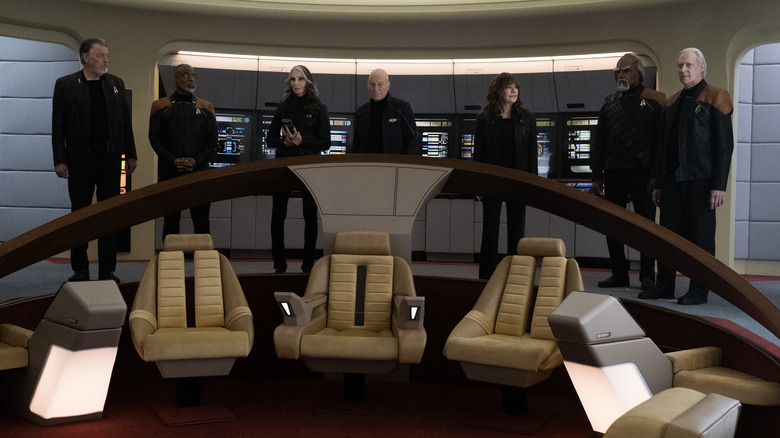
This post contains spoilers for the ninth episode of "Star Trek: Picard," season 3.
In the ninth episode of the third season of "Star Trek: Picard," called "Võx," hundreds of Starfleet vessels have been overtaken by a malevolent Borg consciousness, led by the powerful psychic mind of Jack Crusher (Ed Speleers), the son of Jean-Luc Picard (Patrick Stewart). In order to save the day, the over-65 ensemble of "Star Trek: The Next Generation" stars have to make use of an old-fashioned ship that's not tied into the modern Starfleet wi-fi. Luckily for them, Geordi La Forge (LeVar Burton) has been secretly reconstructing the decades-old Enterprise-D -- the ship from "Star Trek: The Next Generation" -- in secret in his garage. The episode ends with the cast striding out onto a bridge that hasn't been seen since "Star Trek: Generations" in 1994.
This moment may have evoked many wistful waves of nostalgia in the viewer. The characters certainly seem to be a little verklempt to be back in their old workplace where they all first met. Is it a brazen attempt to manipulate the viewer's emotions through the shock of recognition? Perhaps. Does it work? As of this writing, social media is certainly joyously abuzz with the ship's reappearance.
But even the bitter souls who were unmoved by the resurrection of the Enterprise-D still breathed a great sigh of relief. As Picard and company took to the bridge, everything was visible. Even in a wide angle, the rear bridge stations were visible, the helm was visible, the placard on the wall was visible. It was all visible because, for the first time in the show's run, there was finally some decent f***ing lighting.
After skulking in the shadows of the Las Vegas dive bar that was U.S.S. Titan, it felt good to have our pupils finally constrict.
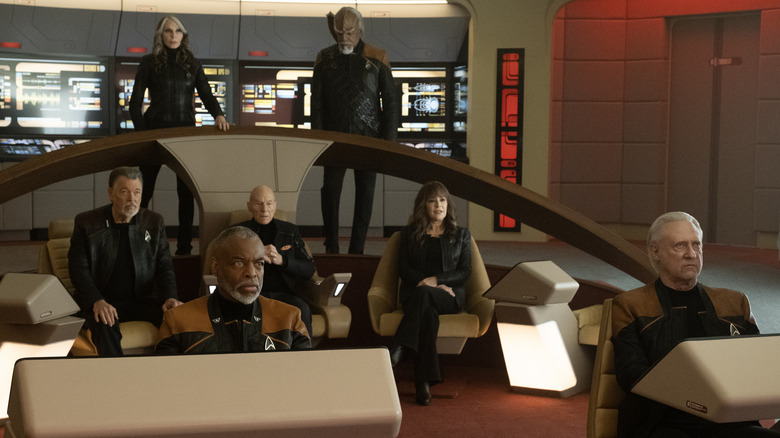
Many Trekkies have long criticized the Enterprise-D for its resemblance to a luxury hotel. Its grey-beige-lavender decor might be the color scheme found in a 1987 frozen yogurt shop or Gap outlet store. It was rounded and soft-edged. The Enterprise-D boasts the only bridge in "Star Trek" that has wooden accents. By comparison, the U.S.S. Titan had steel floor plating, a lot of metallic and plasticine textures, and hard, pointed angles. The same could be said of the U.S.S. Stargazer in season 2 of "Picard," or the La Sirena from season 1. In all cases, the lighting has remained notoriously low, making starship bridges look like strip joints. With illuminated touch-panel controls in aggressively dark rooms, one might assume that all bridge officers would be in sick bay often, complaining about eye strain.
Why are the bridges of starships so f***ing dark? Is it meant to communicate intimacy? Is it so the bridge officers can "disappear" at their own stations, unbothered by the work of others? Or have human eyeballs evolved to be more comfortable in the night? Do surfaces get dirty easily, and the darkness is the only way to hide the stains? It's also possible, though, that neo-Trek audiences only ever saw starships during their darkened "night shift" hours. Maybe, because the new "Star Trek" shows are being made in the era of illuminated smartphones and laptops -- "Next Generation" predates these innovations -- the new designers wanted the starships to look more like a modern desk jockey's workspace.
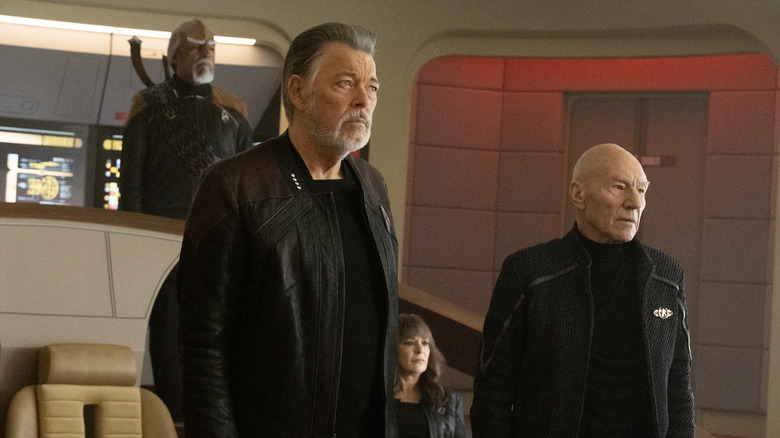
Regardless, the sight of the Enterprise-D was a massive relief for the eyes. Too much of modern "Trek" has adopted a dank, orgy club aesthetic, and the sight of an older starship didn't make us nostalgic for 1990s "Trek," necessarily, so much as for a time when photographers thought to blast everything with light and ensure that viewers could see anything.
Did the bridge of the Enterprise-D look like a hotel lobby? Yes. Was it good for viewers? Also yes. Would it be a more comfortable place to work? Also, also yes.
Bright, even TV lighting, of course, wasn't always the norm. Going back to the 1950s, when "I Love Lucy" was on the air, star cinematographer Karl Freund was hired to design lighting for the relatively new medium. Freund was the photographer on such films as "Metropolis" and "Dracula," and directed "The Mummy" for Universal. For "I Love Lucy," Freund pioneered flat, even sitcom lighting, wherein light fills every corner of the set. This type of lighting is used on sitcoms to this day. On a sitcom, there are no shadows and no dark textures. With the aesthetic established in TV history, even "Star Trek" eventually followed suit, and the bridge of the Enterprise-D was well-lit and visible.
As a Trekkie — that is, as someone who is obsessed with starship details and the functionality of Starfleet vessels — I can speak for all of us when I say that we'd like to see everything happening on the bridge. Trekkies want to see what buttons are being pressed and how engineering stations are shaped. We want to feel like we can operate the ships ourselves.
Hiding your bridge in the shadows makes everything visually unappealing and indistinct. Blast some Freund light in there, please.
Read this next: Every Star Trek Series Ranked From Worst To Best
The post The Enterprise-D Makes it Bright and Clear: Modern Star Trek Bridges Are Too Darn Dark appeared first on /Film.
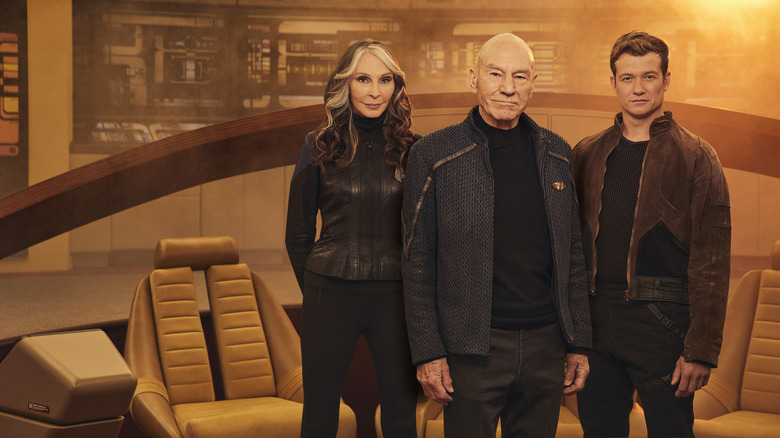
This article contains spoilers for the series finale of "Star Trek: Picard."
The acclaimed final season of "Star Trek: Picard" has come to a stirring and satisfying end — and, with it, the conclusion to the decades-long journey of Patrick Stewart's Jean-Luc Picard and the rest of the beloved crew of explorers from "The Next Generation." But part of the difficult task laid on the shoulders of showrunner and director Terry Matalas involved uniting multiple different shows set around the same time period. That meant tying together loose threads from "Deep Space Nine" like the Changelings, long-missing members of "The Next Generation" such as Ro Laren (Michelle Forbes), and characters from "Star Trek: Voyager" including Tuvok (Tim Russ) and Jeri Ryan's Seven of Nine.
By the end of the finale, the dual threat of the Borg and the Changelings are vanquished once more and seemingly for good. Pulling off such a daring mission required every trick and every remaining ally that Picard and the crew of the U.S.S. Titan could possibly muster up, but apparently, there were meant to be even more cameo appearances waiting in the wings to help our heroes save the day.
One would've involved another key member of the "Voyager" crew: a certain Ensign Harry Kim. Portrayed by Garrett Wang throughout all 7 seasons, Kim has long stood out as a fan-favorite highlight of what's commonly considered a lackluster series. He could've finally received his time in the spotlight had initial plans for the final season of "Picard" panned out, but that was unfortunately not the case. In a recent interview, Matalas explains why.
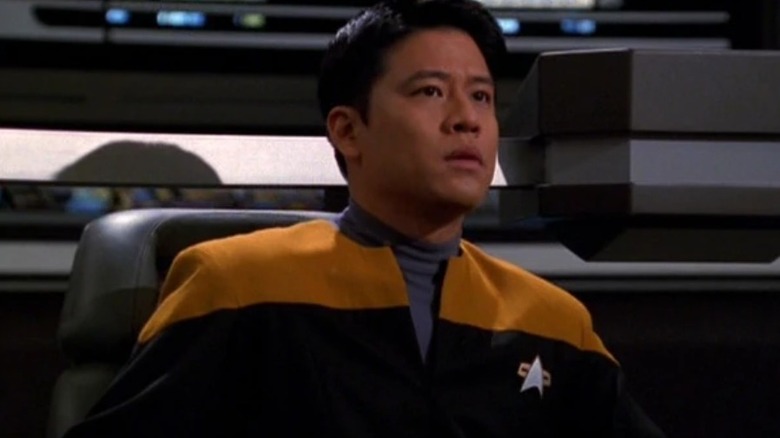
During a roundtable interview attended by /Film's Vanessa Armstrong, "Star Trek: Picard" mastermind Terry Matalas reveals that there were early plans to bring on board one of the most undervalued characters in all of "Trek." An oversight that soon turned into a years-long running gag, Harry Kim's inability to rise through the ranks of Starfleet after the starship Voyager found itself lost for years in the far-off Delta Quadrant caused no shortage of laughs and consternation among the fanbase. Having first boarded Voyager as a lowly Ensign, he proved his worth time and time again ... only to end his run on "Voyager" as, you guessed it, still an Ensign.
Yet unlike characters such as Captain Kathryn Janeway (Kate Mulgrew) or Robert Duncan McNeill's Lieutenant Tom Paris, Kim has never again appeared in "Trek" canon since the finale of "Voyager." That would've finally changed — along with a long-awaited promotion — had things worked out on "Picard," but alas! According to Matalas:
"He was captain actually. [...] I talked to Garrett [Wang] about this and he was very, very disappointed. He was [a] captain and yeah, that's all I can say about it. Again, it's time, it's money. We also didn't want to step on 'Star Trek: Prodigy's toes. It was, but again, you don't want to be greedy, right? It's just, it's ... We're talking about Frontier Day, right? Truly if you had another 20 minutes on Frontier Day, you'd be seeing everybody. You'd be seeing everybody who's in Starfleet in 25th century. You want to know what everybody's up to. But yeah, that was that."
The plot involving Frontier Day allowed some other deep-cut cameos to take shape, but apparently Kim's return was simply not meant to be ... for now, at least.
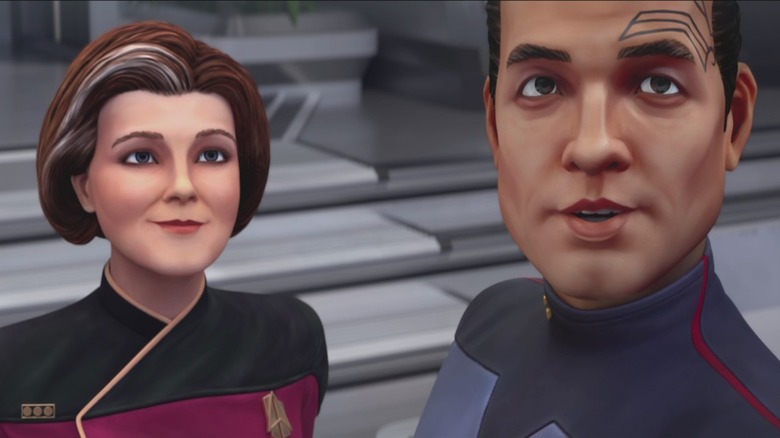
The interesting part of Matalas' comment above, of course, is his reference to "Star Trek: Prodigy." The animated series takes place only a handful of years after the events of "Voyager" and has even made way for characters such as Janeway and her right-hand man, First Officer Chakotay (Robert Beltran), to appear on the show. As much of a pleasant surprise as it would've been to see Wang once more in live-action as a much older and wiser (and promoted) Captain Harry Kim for a few moments at some point in "Picard," perhaps the franchise has bigger things in store for the character.
"Prodigy" has had even more reason to expand on the fates of the Voyager crew and Matalas may have tipped his hand that Kim could eventually show up. In the long run, fans would likely accept a more substantial role for Kim in "Prodigy" than a brief moment of naked fan service in "Picard" for a character who, out of the entire cast, only really matters to Seven of Nine. As it is, "Picard" had a lot going on throughout its third season, so it's easy to imagine why Kim's cameo would be among the first to go for the sake of scheduling and budgets.
But that's the thing about "Trek" — no element of the franchise remains a redheaded stepchild for long. (Okay, except maybe "Star Trek: Into Darkness" or that movie with Picard's clone). "Voyager" may not have the sterling reputation as some of its more widely-celebrated peers, but the creatives in charge and Trekkies alike all seem eager to give the cast their due. Here's to one day getting to see Harry Kim once more on-screen ... this time, with those four pips on the uniform signifying the rank of Captain.
Read this next: 13 Reasons Why Deep Space Nine Is The Best Star Trek Show
The post One of Picard's Cut Cameos Would've Allowed a Beloved Star Trek Character to Finally Rank Up appeared first on /Film.
Read more of this story at Slashdot.
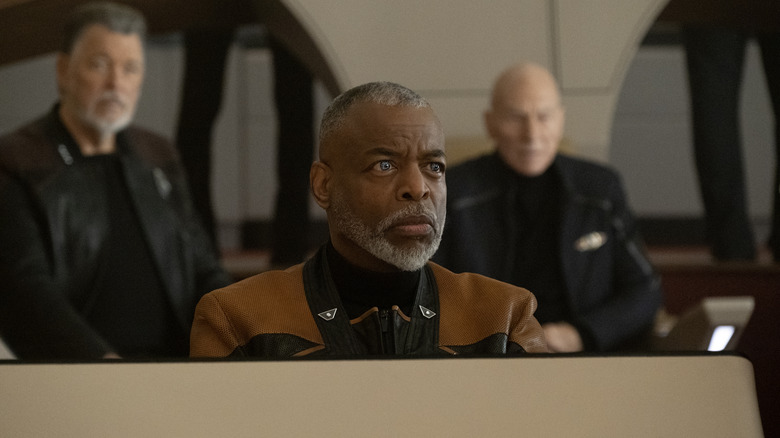
This post contains spoilers for the "Star Trek: Picard" series finale.
In the "Star Trek: Voyager" episode titled "Timeless" (November 18, 1998), Chakotay (Robert Beltran) and Harry Kim (Garrett Wang) found themselves lost in an alternate future after the destruction of their ship. It seems that 15 years before, the Voyager was tinkering with something called a quantum slipstream when the experiment went wrong and the entire starship crashed, killing almost everyone. Chakotay and Kim endeavor to steal a time-altering widget that would allow them to restore the past as it was. In stealing said widget, however, they are pursued by a Federation starship. The ship is the U.S.S. Challenger, a Galaxy-class vessel captained by ... look, Trekkies! It's LeVar Burton as Captain Geordi La Forge! He finally got that command that he always -- or at least once -- wanted.
Geordi's place in the captain's chair in the "Voyager" alternate future would play itself out in official canon in "The Last Generation," the series finale of "Star Trek: Picard." While Picard (Patrick Stewart), Riker (Jonathan Frakes), and Worf (Michael Dorn) left the Enterprise-D to mount a rescue, Geordi would stay behind to command the ship. For the first time since 1998, Trekkies got to see Geordi in command. The character fulfilled a dream he once had as a young lieutenant.
Of course, careers change. Starting with the third season of "Star Trek: The Next Generation," Geordi served as the chief engineer aboard the U.S.S. Enterprise-D and provided the show with the bulk of its wonderful multisyllabic techno-jargon. In wearing the gold uniform, the color used to denote engineers and security officers, La Forge presented himself as being on a very particular career track. He was not aiming to command a vessel, preferring to focus on machines and technical details.
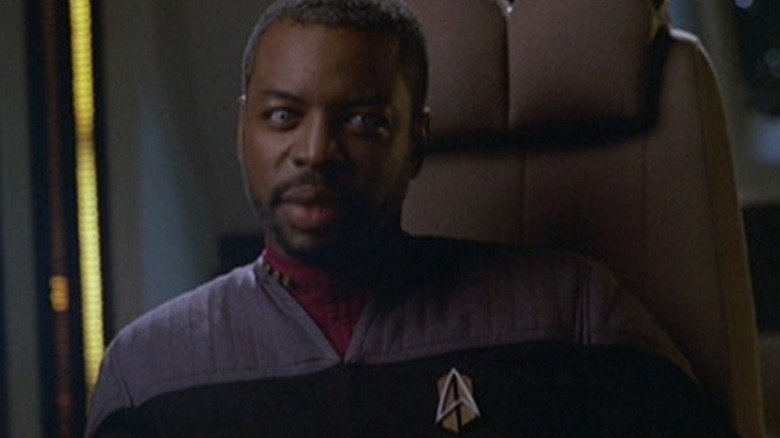
La Forge's technical know-how, in the "official" timeline of "Star Trek: Picard," eventually led him to become the chief curator at a Federation starship museum where ancient ships are put on display. He bore the rank of commodore. For an engineer, this is an appropriate place to end up. He also had a reputation as one of Starfleet's best tinkerers, and Captain Liam Shaw (Todd Stashwick), previously an engineer himself, became a little starstruck when talking to La Forge face-to-face.
But in the first two seasons of "Star Trek: The Next Generation," the young Geordi La Forge wore a red uniform, a declaration that he was on the command career track. The officers in red uniforms aimed to be leaders, needing to study all aspects of a ship and train themselves to manage teams and oversee all of a starship's functions. La Forge clearly wanted to be a captain eventually, and would happily sit in the captain's chair when asked. Even though he was, at the time, only a lieutenant (junior grade).
La Forge was a bridge officer, which put him in close proximity to the captain's chair on multiple occasions. This made the ship's snippy original chief engineer, Lieutenant Logan (Vyto Ruginis), rather miffed in the season 1 "Next Generation" episode "The Arsenal of Freedom" (April 11, 1988). In that episode, the bulk of the Enterprise's senior staff became stranded on a planet, pinned down or injured by automated weapons fire left behind by a long-dead civilization. La Forge was left in command of the ship, dealing with a similar weapon in orbit. When the Enterprise was buffeted by phaser fire, Logan charged to the bridge demanding a command position.
La Forge, stalwart, refused. Good for him.
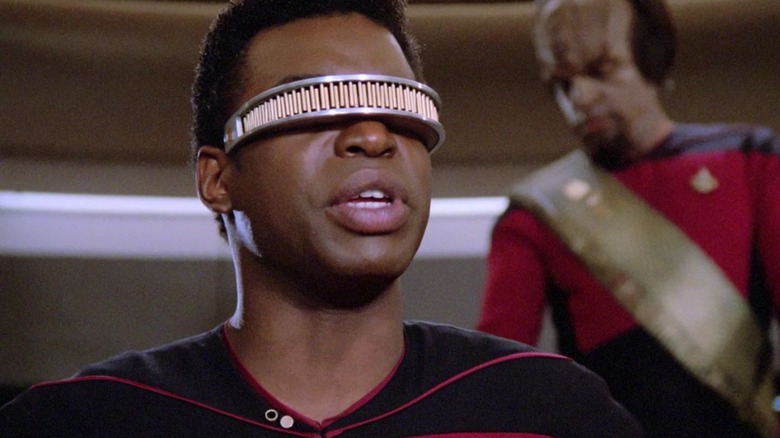
Indeed, in "The Arsenal of Freedom," Geordi's solution for the crisis du jour is brilliant. The ship attacking him is invisible and its attacks are increasingly destructive. He eventually has the great idea of separating the Enterprise's saucer section and ceding control of it over to Logan. Using the drive section, Geordi lures the invisible ship into the upper part of a planet's atmosphere, causing it to become visible as it heats up. La Forge has to get command advice from Counselor Troi (Marina Sirtis) and reassure the ensigns in his command that everything will be fine. When Picard returns to the ship, he lets Geordi stay in command until it is reunited with its saucer. It seems that Geordi would have made a pretty excellent captain.
La Forge's engineering career, of course, interrupted that particular ambition, leaving "Arsenal of Freedom" fans a little upset. It seemed that Geordi was fated to never be captain again.
Thankfully, "The Last Generation" will finally leave said fans sated. Geordi, now perhaps in his 80s, is left in command of the Enterprise-D he reconstructed himself (it was destroyed in "Star Trek: Generations"). At the helm sits Data (Brent Spiner) who pilots the ship, Millennium Falcon-style, into a vast Borg vessel, hoping to bomb its core. Geordi lets Data do his piloting, stays in contact with his team, and again asks Troi for advice. It's been decades for both the actor and the character, but it seems that being a captain was something he never lost a knack for.
"Picard" may not take place in a timeline where Geordi became a starship captain, but fans of the famed engineer finally get to see something they've longed for since 1988. It only took 35 years.
Read this next: 14 Underrated Star Trek: The Next Generation Episodes
The post The Picard Finale Finally Gives Star Trek Fans Something They've Wanted For Years appeared first on /Film.

Retirement is one of those life stages that seems inevitable. From an early age, it’s pounded into us: You have to save for retirement, and you have to plan for retirement, which pretty much implies that you have to retire. And after a few decades spent working in order to pay the bills, retirement certainly becomes…
While many of us at Engadget are passionate about cooking, it turns out that tech blogging isn’t the most efficient path to owning a large kitchen. No matter: We try to make the most of our cramped apartments regardless, and we’ve managed to (mostly) stay sane along the way thanks in large part to a few space-spacing appliances and cooking tools. If you’re in a similar situation and have been trying to fend off the urge to order out every night, we’ve rounded up a handful of our favorite small kitchen essentials below.
This article originally appeared on Engadget at https://www.engadget.com/small-kitchen-essential-gadgets-irl-154530643.html?src=rssThe U.S. Department of Commerce's Bureau of Industry and Security this week imposed a $300 million fine on Seagate for violating U.S. export control restrictions. The storage company has admitted to shipping 7.4 million hard drives to Huawei in the 2020-2021 period, in direct violation of restrictions imposed by the U.S. government against the Chinese company in 2020. In response to those actions, the Bureau of Industry and Security has levied the largest standalone fine in the department's history against Seagate – one that will take Seagate several years to pay off.
Back in 2019 – 2020, the U.S. Department of Commerce's Bureau of Industry and Security (BIS) added Huawei and virtually all of its subsidiaries to its Entity List and imposed export rules that required any company (U.S.-based or foreign) to obtain an export license from the U.S. DoC to supply any product, item, or service to Huawei that featured an American technology.
Export controls placed on Huawei primarily concerned semiconductors. In particular, chips developed or made in the United States or elsewhere 'from U.S. software or technology' are regarded as the U.S. chips under the rules that went into effect in August, 2020. However, Seagate's hard drives are also categorized as export-controlled items because they utilize American-designed EDA tools and U.S.-made equipment for their controllers and memory.
It is noteworthy that many of export licenses were actually granted by the BIS, which is how Huawei acquired many items it needed from American companies as well as multinational corporations. This was not the case with Seagate, however, who opted to proceed without a license. The company shipped about 7.42 million hard drives valued at $1.104 billion to Huawei between August 17, 2020, and September 29, 2021 on as many as 429 occasions without authorization. Meaning that this was not a single error, but as the company has admitted to as part of their settlement, was rather a deliberate business practice.
Since both Toshiba and Western Digital ceased selling HDDs to Huawei without an approval from the U.S. authorities in August 2020, Seagate became Huawei's sole hard drive provider. Subsequently the two companies entered into a three-year Strategic Cooperation Agreement granting Seagate priority over other Huawei suppliers. Furthermore, in March, 2021, Seagate and Huawei forged a Long-Term Agreement, which involved the purchase of over five million HDDs. As a result, Seagate became Huawei's "Key Strategic Supplier" as other hard dirve makers declined to export their products.
"Even after Huawei was placed on the Entity List for conduct inimical to our national security, and its competitors had stopped selling to them due to our foreign direct product rule, Seagate continued sending hard disk drives to Huawei,"said Matthew S. Axelrod , Assistant Secretary for Export Enforcement.
Under the terms of the settlement agreement, Seagate will pay a $300 million penalty to the U.S. Department of Commerce. The company will be paying off the fine piecemeal, making quarterly installments of $15 million over five years, starting from October 31, 2023. BIS claims that $300 million is two times more than Seagate earned in profits while violating the export rules.
Also, both parties agreed to conduct three audits to ensure Seagate's compliance with Export Administration Regulations, with one audit by an independent third-party consultant chosen by Seagate. In turn, BIS will not initiate further administrative proceedings against Seagate for any violations related to the transactions in the agreement.
"Today's action is the consequence: the largest standalone administrative resolution in our agency's history," added Axelrod. "This settlement is a clarion call about the need for companies to comply rigorously with BIS export rules, as our enforcement team works to ensure both our national security and a level playing field."
Sources: Seagate, U.S. Department of Commerce Bureau of Industry and Security
Read more of this story at Slashdot.
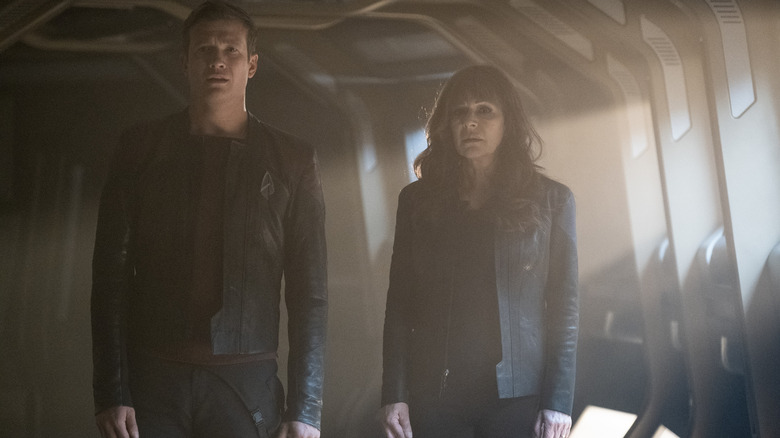
This article contains spoilers for the latest episode of "Star Trek: Picard."
Last night, "Star Trek: Picard" wrapped up its 3-season run with its most widely-celebrated arc yet. (You can check out /Film's recap by Witney Seibold here.) Jean-Luc Picard (Patrick Stewart), Will Riker (Jonathan Frakes), and the rest of the Enterprise crew all faced their most formidable enemy, the Borg, and managed to defeat them once and for all. Cue the happy celebrations, the extended epilogue wrapping up the stories of our classic heroes while setting the stage for new adventures to come, and an emotional final scene that sent the original "The Next Generation" cast off into the sunset in as satisfying a way as anyone could've asked for.
All's well that ends well, right? Well, maybe not.
A large part of the season dealt with the presence of Picard and Beverly Crusher's (Gates McFadden) secret lovechild, Jack (Ed Speleers). Although the estranged father and son eventually bonded with one another throughout the course of the 10 episodes, the finale ended with both generations in very different places. Picard and his old crew retired to play another round of poker, an overt callback to the series finale of "The Next Generation" back in 1994. But for Jack, Captain Seven of Nine (Jeri Ryan), Raffi (Michelle Hurd), and the young crew of the U.S.S. Titan (which has now been rebranded as the Enterprise, cool enough), their voyages in outer space are only just beginning.
Wouldn't it be a shame if an interdimensional god interfered with everything again? Yes, the surprising post-credits scene in the "Picard" finale brought back John de Lancie's meddlesome Q, this time to ruin Jack's day. For those who may have been wondering how this came to be, showrunner Terry Matalas is now spilling the beans.
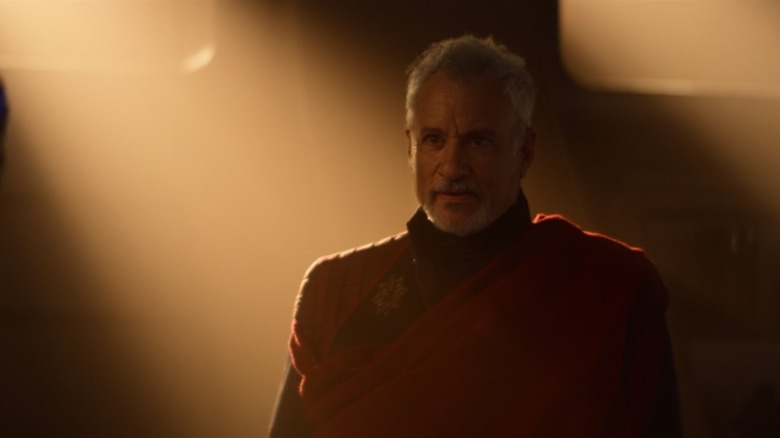
As much as season 3 of "Star Trek: Picard" has earned raves across the board, that hasn't always been the case for this spin-off/sequel series. Season 2 in particular ended up dividing fans, especially in the finale when the show gave longtime enemies Picard and Q a weepy goodbye ... complete with an actual, affectionate hug! While I guess I'm in the minority who thought that was a well-earned coda to their tumultuous relationship over the decades, those disgruntled fans apparently were not alone in wanting a sort of redo to Q's time in "Trek" lore.
Showrunner Terry Matalas recently held a roundtable interview that /Film's Vanessa Armstrong attended, where he divulged exactly how this Q-centric post-credits scene in "Picard" came about:
"It was an idea I had all the way back when we were shooting [Q's] last scene in season 2. I knew we were going to tell this story and I went up to John [de Lancie] and I was like, 'I've got this idea for a post credit scene where he's back.' And he was like, 'Yes.' And John and I are dear friends, so we continued to talk about it whenever we hang out. And he was like, 'I'll be back.'"
Revealing that they only had "20 minutes" to shoot what would become one of his "favorite" scenes in the finale, Matalas was clearly giddy about the prospects of retconning Q back into continuity. Whether this flies in the face of the season 2 finale or not, I think most Trekkies are simply happy to get more of de Lancie's phenomenal, scenery-chewing performance as Q in the future. When exactly will that be? Paramount hasn't announced a "Star Trek: Legacy" spin-off just yet, but hopefully, it's only a matter of time.
Read this next: 14 Underrated Star Trek: The Next Generation Episodes
The post That Post-Credits Scene in Picard Season 3 Was Cooked Up During Season 2 appeared first on /Film.
Read more of this story at Slashdot.
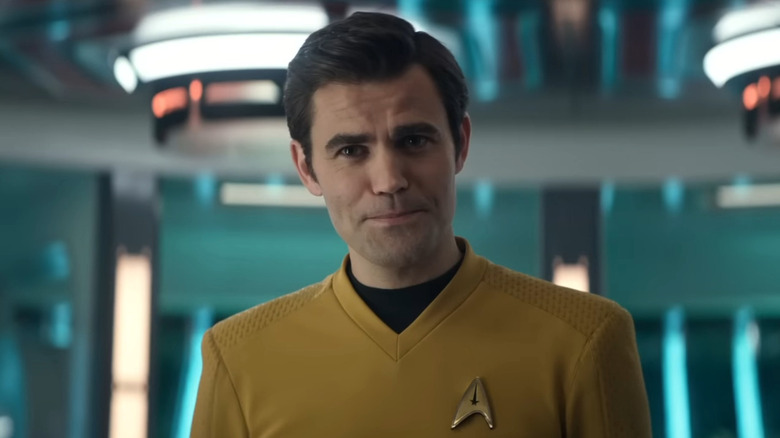
The trailer for season 2 of "Star Trek: Strange New Worlds" is here with glimpses of upcoming adventure and good humor from our beloved Enterprise crew. It's like a friendly greeting, a promise of lofty things to come. But while we see the showrunners waving from such great heights, we're about to bring them down now.
Sure, everything looks perfect from far away and I'm trying my best to leave it there, but there's a comedic beat that sounded pretty thin in the trailer, and the more I think about it, the more I realize that it frankly will not fly.
The "Strange New Worlds" trailer ends with James T. Kirk (Paul Wesley), the future captain of the Enterprise, getting confused by a revolving door. And when La'an (Christina Chong) asks him, "Never seen a revolving door before?" he says, "I'm from space."
Hahahahahahahahahaha. James T. Kirk is from Iowa and we all know it.
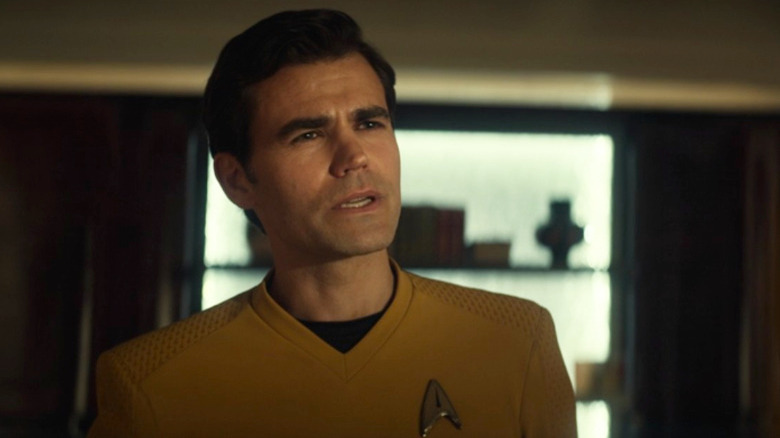
Yes, Kirk may spend an awful lot of time in outer space, and he may even have been born there. But he grew up in Iowa. He says he's from Iowa rather a lot, actually. Not only did Shatner's version of the character say he was from Iowa, in the expanded canon and in blockbuster films like "Star Trek IV: The Voyage Home," but the prequel version of the character in "Strange New Worlds" says it too.
In fact, the very last thing we heard Kirk clearly say in the first season finale of this hit show, before the audio started fading out, was, "I grew up in Iowa."
Kirk didn't spend his entire childhood in Iowa. Fans of the original series probably remember a classic episode called "The Conscience of the King," in which it's revealed that young James T. Kirk was also a survivor of a horrific genocide on Tarsus IV, where the threat of starvation led the governor, Kodos, to order half of the colony's population executed, in order to save the other half. Kodos went on to live in hiding, eventually finding a new career as a professional Shakespearean actor, but that's a whole other story and we're getting a little off-track here.
The point is that Kirk may have lived a lot of his life in outer space, but according to the character, even in the most recent episode of "Strange New Worlds," he grew up in Iowa. He's not "from space." Even his personnel records in "Strange New Worlds" say he's from Earth. The showrunners of "Strange New Worlds" know this, and they abandoned it just to make a weird and unnecessarily distracting joke? That's a really odd choice, isn't it?
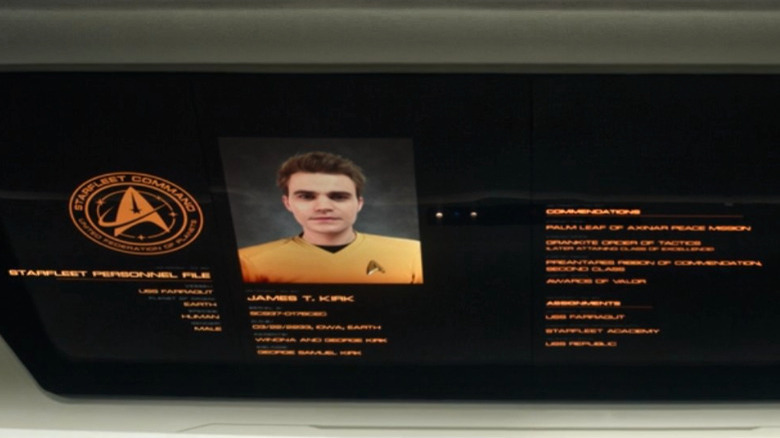
Now, obviously, this whole line of discussion is a little pedantic.
Okay, its a lot pedantic. But in my defense, this is "Star Trek." As far as sci-fi geekery goes, "Star Trek" practically invented being pedantic. The sense of continuity that "Star Trek" creator Gene Roddenberry's original creation developed over the last sixty-odd years is all-consuming, and great pains have been taken to justify any minor inconsistency within its framework so that the world of these characters can be taken seriously and thought of as extremely real to "Trek" fans.
So while it's abundantly clear that the line, "I'm from space," in the "Strange New Worlds" trailer is, again, intended to be a joke, something we're supposed to laugh at and not overanalyze, it's also joked that entirely depends on the audience not knowing that James T. Kirk is from Iowa in order to be funny, in a franchise where his character repeatedly says he's from Iowa. A joke for "Star Trek" fans that relies on "Star Trek" fans not knowing a lot about "Star Trek" is a very weird joke indeed. What's more, a joke that isn't intended for "Star Trek" fans that nevertheless will be seen by practically every "Star Trek" fan is going to stick out like a sore thumb to, let's face it, all of those "Star Trek" fans.
To put it another way, for non-"Star Trek" fans who don't get why this is so weird to "Star Trek" nerds: Imagine if King Kong moved back to Skull Island and he couldn't remember how his giant King Kong door worked. And so Godzilla asks him, "Never seen a giant King Kong door before?", and King Kong sassily responds, "I'm from New York."
No you're not, King Kong. You're from Skull Island. Just like James T. Kirk is from freakin' Iowa.
"Star Trek: Strange New Worlds" season 2 will premiere on June 15, 2023 exclusively on Paramount+.
Read this next: Every Star Trek Series Ranked From Worst To Best
The post That Final Joke in the Strange New Worlds Season 2 Trailer Raises a Startling Number of Star Trek Questions appeared first on /Film.